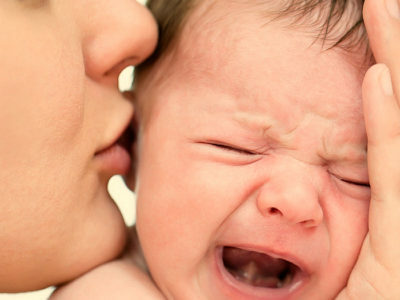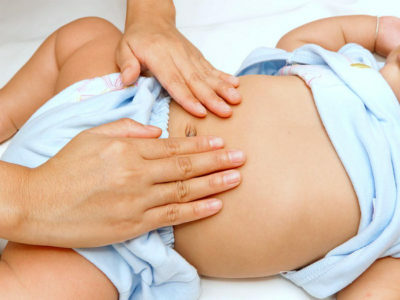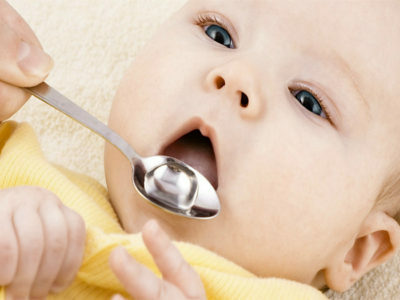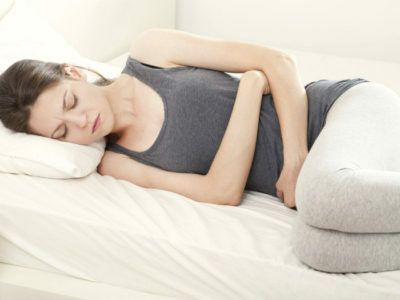1 Etiology of the disease in infants
In the first two weeks of life, the baby gets enough for it to colonize the microorganisms with the mother's milk, but further the digestion of food due to a lack of bacteria begins to occur. The small intestine is unable to cope. The remains of food accumulate in the intestines, and the fermentation process starts. Every minute gas bubbles are formed, accumulating, they expand the walls of the intestine and cause colic in the newborn.

Recommended to read
- How to treat colic in newborns
- What is characteristic of subatrophic gastritis
- What massage will help against colic in newborns
- Effective agent for gastritis and stomach ulcer
The reasons for their occurrence are many, the most frequent is maternal nutrition. For example, nursing should not eat cabbage and beans, as they contribute to gassing and cause a painful swelling of the abdomen. Each mother should from the first days of the appearance of her baby adhere to a diet and move to a common table gradually.
The technique of breastfeeding also plays an important role. After all, if the nipple with the areola is not correctly grasped, air can leak with food into the stomach and cause colic.
In the modern world, many mothers refuse breastfeeding and from the first days start to give various advertised mixtures, the amount of bifidobacteria in which is not enough for the body. Despite the large selection of mixtures on the market, the replacement of mother's milk is still impossible.
The development of colic occurs during the transition of the baby to artificial nutrition. To check the presence of the necessary amount of bacteria in the body, doctors recommend taking a stool test.
One of the prevention of spasms is prolonged breastfeeding so that beneficial bacteria can enter the body of the baby as long as possible. According to WHO recommendations, it is advisable to breastfeed for up to 6 months without different supplements. A complementary meal to start step by step and in small portions.
Other causes of colic in babies
-
 IMPORTANT TO KNOW! Gastritis? Ulcer? To have a stomach ulcer not turned into cancer, drink a glass. ..Read the article & gt; & gt;
IMPORTANT TO KNOW! Gastritis? Ulcer? To have a stomach ulcer not turned into cancer, drink a glass. ..Read the article & gt; & gt;
Colic in newborns depends on the speed of movement along the gastrointestinal tract of accepted food, an incorrectly diluted mixture.
The presence of jelly can also provoke the appearance of colic. Some changes in the nervous system of the baby can lead to gas formation. Therefore, you should contact the clinic for medical preventive examinations, especially for a neurologist.
2 Symptomatic symptoms in infants
Symptoms of colic in newborns should be distinguished from intestinal infection. To do this, you need to observe his behavior during the period of feeding.
- For attacks of spasms, the same time of day is characteristic, more often in the evening or at night, a sudden appearance.
- The baby starts to wince, groan, face turns red, turns, trying to point out her condition, so that my mother can understand and help.
- When the pain appears, the baby pulls the legs, trying to press them against the tummy and unbend, arches the backrest and strains heavily.
- Handles clenches into the jaws.
- Crying loudly and strongly.
- If you feel at this time the stomach, you can note its hardness, putting an ear to the tummy - to hear the rumbling of the intestines.
- After regurgitation or emptying of the intestine, the gas disappears, the pain subsides, and the child calms down. After a while the signs of colic are repeated.
- The rest of the time the baby feels well, active, eats well and gaining weight.
-
 Gastroenterologist. IMPORTANT: "I beg you, if you started to worry about abdominal pain, heartburn, nausea, do not do gases. .."Read more & gt; & gt;
Gastroenterologist. IMPORTANT: "I beg you, if you started to worry about abdominal pain, heartburn, nausea, do not do gases. .."Read more & gt; & gt;

3 What time of day are the symptoms?
In the daytime the kid recognizes the world and pays attention to every little thing. However, already by 18 o'clock the process of fermentation is started, and pain begins. The most important help to the baby are the mother's hands, from which comes warmth and affection. This psychological moment calms the child and even eliminates some of the colic. Mom needs to take the child so that the hand was under the tummy, and the baby's head was lying on the palm of your hand. The other hand should be stroked back. Or just press the baby to yourself and stroking the back, help to escape troubling gases.

If a baby already has a month, then you can turn it over on your tummy, having previously placed a heated diaper, and continue to stroke the baby on the back.
You can use some tricks with massage: raise the legs of the baby and press the knees to the stomach, which will release the way to the exit of gases;stroking the abdomen clockwise, while trying not to press and irritate the right hypochondrium, the location of the liver.
A good effect in the fight against colic is given by some medicines. For example, hofitol, bobotik, baby, plankteks and others. However, doctors do not recommend giving drugs during the first 21 days of life of babies, for this purpose it is better to use folk methods of treatment, massages and dill water.
ADVICE FROM THE MAIN GASTROENTEROLOGIST
Korotov SV: "I can recommend only one remedy for the rapid treatment of Ulcer and Gastritis, which is now recommended by the Ministry of Health. .." Read testimonials & gt; & gt;

Some examples of folk treatment for colic:
- use of tea from herbs and infusions. They must be given before each meal. Tea is made from chamomile, fennel, mint, ginger;
- infusion of dill 2-3 teaspoons 2 times a day;
- a warm bath with chamomile will help with strong pain;
- using a gas pipe.
When are spasms?
In medicine, it is considered that for 4 months, the adaptation of the intestine to nutrition has formed, the intestine begins to adapt to various influences of the external world, signs of colic decrease.
4 Recommendations for feeding mothers
After delivery, a woman should refrain from taking bread, chocolate, fruits, berries and vegetables in fresh form, dairy products and legumes. The diet should be kept until the end of the first month, then gradually expand its diet, with the addition of certain products preferably in the first half of the day, in order to observe the reaction of the child's body to the product.
And also the psychological state of the mother will play a role, the child as a sponge perceives all the emotions of the mother. If the mother is irritated or worried, the appearance of colic will not keep you waiting.
WE RECOMMEND!
For prophylaxis and treatment of Digestive Gastrointestinal Diseases our readers advise Monastic tea. This unique remedy consists of 9 medicinal herbs useful for digestion, which not only supplement, but also strengthen each other's actions. Monastic tea will not only eliminate all symptoms of the gastrointestinal tract and digestive system, but will also permanently eliminate the cause of its occurrence.
Opinion of doctors. .. "
In addition to the correct attachment to the chest, you should pay attention to getting the baby not only the upper milk, but also the bottom. When there is a lot of milk, the baby receives unripe top milk, and the amount of lactose in it is small. Therefore, a certain part of the milk takes place before feeding.
Treatment measures for colic in newborns can be different, the choice is for moms who want to quickly rid their child of a painful condition. However, American scientists are sure that folk medicine is ineffective here and the process of colic runs on its own according to the time required. They conducted experiments in which it was noted that only three of the dozen helped people's methods. These three children, scientists wrote off on the proximity of mothers with babies and peace of mind of the parents.
- 1 Etiology of the disease in infants
- 2 Characteristic symptoms in infants
- 3 At what time of day are the symptoms manifested?
- 4 Recommendations for mothers nutrition
Colic in a newborn, the symptoms of which affect almost all babies, are known to every parent. After all, when a baby is born, there are no useful microorganisms in his body, because in the mother's belly the child was protected and did not need them. The food delivered to the baby through the umbilical cord was digested with enzymes.
So the kid received the vitamins and microelements he needed. And with the birth of a child falls into an environment that carries a lot of microorganisms, which are not always useful for a newborn. To struggle with the last while there is no opportunity because of absence of immunity. The population of useful bifidobacteria and other species occurs with the onset of breastfeeding.
Do you have gastritis?
GALINA SAVINA: "How easy is it to cure gastritis at home for 1 month. A proven method - write down a recipe. ..!"Read more & gt; & gt;



